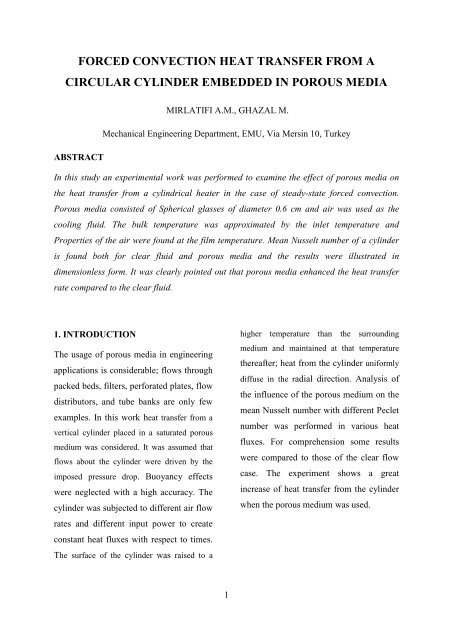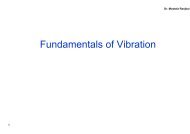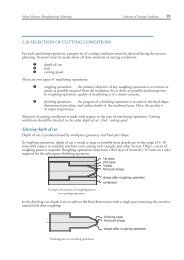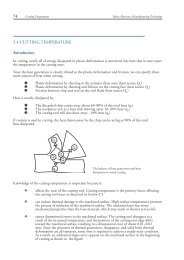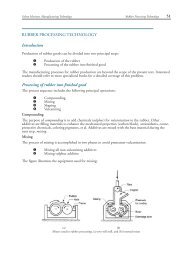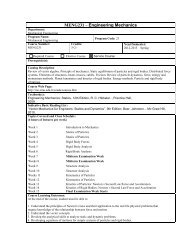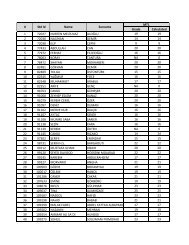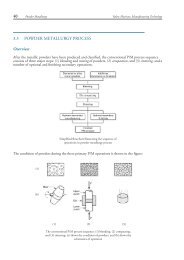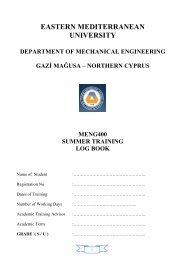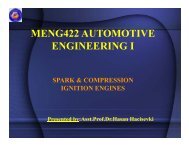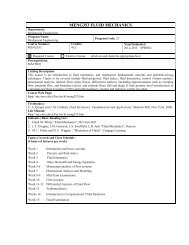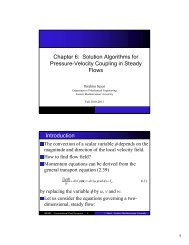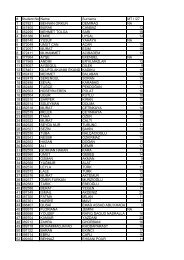forced convection heat transfer from a circular cylinder embedded in ...
forced convection heat transfer from a circular cylinder embedded in ...
forced convection heat transfer from a circular cylinder embedded in ...
Create successful ePaper yourself
Turn your PDF publications into a flip-book with our unique Google optimized e-Paper software.
FORCED CONVECTION HEAT TRANSFER FROM A<br />
CIRCULAR CYLINDER EMBEDDED IN POROUS MEDIA<br />
MIRLATIFI A.M., GHAZAL M.<br />
Mechanical Eng<strong>in</strong>eer<strong>in</strong>g Department, EMU, Via Mers<strong>in</strong> 10, Turkey<br />
ABSTRACT<br />
In this study an experimental work was performed to exam<strong>in</strong>e the effect of porous media on<br />
the <strong>heat</strong> <strong>transfer</strong> <strong>from</strong> a cyl<strong>in</strong>drical <strong>heat</strong>er <strong>in</strong> the case of steady-state <strong>forced</strong> <strong>convection</strong>.<br />
Porous media consisted of Spherical glasses of diameter 0.6 cm and air was used as the<br />
cool<strong>in</strong>g fluid. The bulk temperature was approximated by the <strong>in</strong>let temperature and<br />
Properties of the air were found at the film temperature. Mean Nusselt number of a <strong>cyl<strong>in</strong>der</strong><br />
is found both for clear fluid and porous media and the results were illustrated <strong>in</strong><br />
dimensionless form. It was clearly po<strong>in</strong>ted out that porous media enhanced the <strong>heat</strong> <strong>transfer</strong><br />
rate compared to the clear fluid.<br />
1. INTRODUCTION<br />
The usage of porous media <strong>in</strong> eng<strong>in</strong>eer<strong>in</strong>g<br />
applications is considerable; flows through<br />
packed beds, filters, perforated plates, flow<br />
distributors, and tube banks are only few<br />
examples. In this work <strong>heat</strong> <strong>transfer</strong> <strong>from</strong> a<br />
vertical <strong>cyl<strong>in</strong>der</strong> placed <strong>in</strong> a saturated porous<br />
medium was considered. It was assumed that<br />
flows about the <strong>cyl<strong>in</strong>der</strong> were driven by the<br />
imposed pressure drop. Buoyancy effects<br />
were neglected with a high accuracy. The<br />
<strong>cyl<strong>in</strong>der</strong> was subjected to different air flow<br />
rates and different <strong>in</strong>put power to create<br />
constant <strong>heat</strong> fluxes with respect to times.<br />
The surface of the <strong>cyl<strong>in</strong>der</strong> was raised to a<br />
higher temperature than the surround<strong>in</strong>g<br />
medium and ma<strong>in</strong>ta<strong>in</strong>ed at that temperature<br />
thereafter; <strong>heat</strong> <strong>from</strong> the <strong>cyl<strong>in</strong>der</strong> uniformly<br />
diffuse <strong>in</strong> the radial direction. Analysis of<br />
the <strong>in</strong>fluence of the porous medium on the<br />
mean Nusselt number with different Peclet<br />
number was performed <strong>in</strong> various <strong>heat</strong><br />
fluxes. For comprehension some results<br />
were compared to those of the clear flow<br />
case. The experiment shows a great<br />
<strong>in</strong>crease of <strong>heat</strong> <strong>transfer</strong> <strong>from</strong> the <strong>cyl<strong>in</strong>der</strong><br />
when the porous medium was used.<br />
1
NOMENCLATURE<br />
L<br />
Diameter of the porous<br />
Diameter of the <strong>cyl<strong>in</strong>der</strong> (16 mm)<br />
Darcy Number,<br />
Permeability<br />
Thermal conductivity of Spheres<br />
Thermal conductivity of air<br />
Thermal conductivity,<br />
( )<br />
Length of the bed<br />
Prandtl number<br />
Q Heat flux ( )<br />
Heat flux per unit area ( )<br />
Reynolds number<br />
Inlet temperature<br />
Surface temperature of the <strong>cyl<strong>in</strong>der</strong><br />
Average velocity<br />
Diffusivity<br />
Porosity<br />
Nu Nusselt number (( – ) )<br />
P Pressure<br />
Pe Peclet number,<br />
K<strong>in</strong>ematic viscosity<br />
ρ Density of air<br />
µ Viscosity<br />
3. EXPERIMENTAL METHOD<br />
The experiment <strong>in</strong>cludes a bed of porous<br />
media <strong>in</strong> an <strong>in</strong>sulated duct. Inlet velocity<br />
was measured by hot wire transducer and<br />
pressure drop was measured before and<br />
after the porous bed us<strong>in</strong>g a monometer. A<br />
power supply was connected to a<br />
cyl<strong>in</strong>drical <strong>heat</strong>er <strong>embedded</strong> <strong>in</strong> the porous<br />
media to generate <strong>heat</strong> ( ). T-type<br />
thermocouples were used to measure the<br />
surface temperature of the <strong>cyl<strong>in</strong>der</strong> ( ) as<br />
well as the flow temperature <strong>in</strong> the<br />
downstream, (figures 1 & 2). The porosity<br />
( ) was found to be 0.388. Subsequently,<br />
permeability was obta<strong>in</strong>ed by us<strong>in</strong>g<br />
Kozeny-Carman equation:<br />
( )<br />
where is the diameter of the spheres, (6<br />
mm). Thermal conductivity of the porous<br />
material was taken as 1.3 W/m °C.<br />
Permeability was found to be<br />
and Darcy number was calculated<br />
as .<br />
2
Figure 1 : Experimental Setup (Front<br />
View)<br />
each air flow five different <strong>heat</strong> fluxes<br />
were supplied to the element. By chang<strong>in</strong>g<br />
the <strong>heat</strong> flux and wait<strong>in</strong>g for a while to<br />
reach to a steady state surface temperature,<br />
all temperatures were automatically<br />
recorded by the means of a data acquisition<br />
system. The whole process was done for<br />
both the clear flow and flow <strong>in</strong> the porous<br />
medium. To compare the <strong>heat</strong> <strong>transfer</strong> rate<br />
for each medium, Nusselt number versus<br />
Reynolds number were plotted for all the<br />
cases.<br />
4. RESULTS AND DISCUSSION<br />
Figure 2 : Experimental Setup (top view)<br />
The air flow was supplied by the use of a<br />
suction type w<strong>in</strong>d tunnel. The <strong>in</strong>let<br />
temperature, the surface temperature of the<br />
cyl<strong>in</strong>drical <strong>heat</strong>er, and downstream<br />
temperature <strong>in</strong> the porous media, were<br />
recorded through the data acquisition<br />
system. The experiment was carried out for<br />
three different air velocities, which were<br />
measured us<strong>in</strong>g the hot wire transducer.<br />
Pressure drop before and after the porous<br />
bed was measures us<strong>in</strong>g a manometer. For<br />
Table 1 shows different <strong>heat</strong> fluxes and<br />
their correspond<strong>in</strong>g steady state surface<br />
temperature for various numbers. The<br />
difference between the surface temperature<br />
of the cyl<strong>in</strong>drical <strong>heat</strong>er and <strong>in</strong>let<br />
temperature <strong>in</strong> the case of porous media is<br />
much lower than the case of clear fluid.<br />
For example, <strong>in</strong> the case of Re = 1800 and<br />
Q=15.9 W the difference between the <strong>in</strong>let<br />
temperature and the surface temperature is<br />
17.2 ºc <strong>in</strong> the porous medium case and<br />
50.1 ºc <strong>in</strong> the case of clear flow. One of the<br />
ma<strong>in</strong> aims of such setup is to enhance the<br />
<strong>heat</strong> <strong>transfer</strong> and to decrease the<br />
temperature of the element to the lowest<br />
degree possible. Here, we can see the<br />
difference <strong>in</strong> the <strong>heat</strong> <strong>transfer</strong><br />
effectiveness. That is, the temperature of<br />
the surface of the <strong>cyl<strong>in</strong>der</strong> recorded 35.7 ºc<br />
3
<strong>in</strong> the porous medium case and 70 ºc <strong>in</strong> the<br />
case of clear flow. This advantage can be<br />
implemented <strong>in</strong> <strong>heat</strong> exchangers; if our<br />
element is to be considered as a part of<br />
<strong>heat</strong> exchanger, the surface temperature of<br />
the f<strong>in</strong> or the pipe is go<strong>in</strong>g to be less <strong>in</strong> the<br />
case of porous medium than that of the<br />
clear flow.<br />
The pressure drop measured dur<strong>in</strong>g the<br />
experiment was found to be 667, 588, and<br />
379 ( ) for Reynolds numbers 1800,<br />
1600, and 1200 respectively.<br />
Calculat<strong>in</strong>g the correspond<strong>in</strong>g Darcy<br />
velocities by equation:<br />
velocities. Therefore, this equation was<br />
discarded <strong>in</strong> the further calculations.<br />
Instead, the velocities, measured us<strong>in</strong>g the<br />
hot wire transducer, were taken <strong>in</strong>to<br />
account as the real velocities.<br />
Figure 3 shows versus Renolds<br />
number. The more is the <strong>heat</strong> flux the<br />
higher is the mean Nusselt number, which<br />
is nearly constant for different Reynolds<br />
numbers. The results show conformity<br />
with the similarity solution, which is<br />
<strong>in</strong> the porous media, [1].<br />
( )<br />
resulted <strong>in</strong> 4.4, 3.98, and 2.56<br />
, which<br />
is twice as higher as the measured<br />
Table 1: <strong>in</strong>let, element’s surface temperature, and the difference between them, for different<br />
Re and <strong>heat</strong> flux for both of the cases.<br />
With porous medium<br />
Clear flow<br />
Re Q(W)<br />
1800 15.9 35.7 18.6 17.2 71.0 20.9 50.1<br />
1800 13.3 32.2 17.5 14.7 63.4 20.0 43.4<br />
1800 11.4 30.6 18.0 12.5 58.0 20.0 38.0<br />
1800 9.6 28.3 17.6 10.7 52.0 19.9 32.1<br />
1800 8.0 26.6 17.8 8.8 47.3 19.7 27.6<br />
1600 15.9 35.7 17.4 18.3 73.9 19.6 54.2<br />
1600 13.3 33.2 17.3 15.9 66.4 19.6 46.7<br />
1600 11.4 30.4 17.1 13.3 59.8 19.6 40.2<br />
1600 9.6 28.4 17.2 11.2 53.3 19.7 33.7<br />
1600 8.0 26.6 17.1 9.5 47.4 19.5 27.9<br />
1200 15.9 39.1 17.1 22.0 74.0 19.2 54.8<br />
1200 13.3 36.1 17.3 18.8 66.0 19.3 46.8<br />
1200 11.4 33.1 17.0 16.1 59.3 19.3 40.0<br />
1200 9.6 30.7 17.1 13.6 52.7 19.2 33.6<br />
1200 8.0 28.2 17.0 11.2 46.9 19.2 27.7<br />
4
Variation of Nu <strong>in</strong> porous medium<br />
us<strong>in</strong>g porous media for <strong>heat</strong> <strong>transfer</strong><br />
Nu/Pe^.5<br />
14.4<br />
14.2<br />
14<br />
13.8<br />
13.6<br />
q''=2.53 kw/m^2<br />
q''=2.12 kw/m^2<br />
q''=1.86 kw/m^2<br />
q''=1.53 kw/m^2<br />
q''=1.27 kw/m^2<br />
problems is emphasized.<br />
3.50<br />
Comparison of Nu for both <strong>heat</strong> <strong>transfer</strong> <strong>in</strong> porous<br />
medium and <strong>in</strong> a clear flow<br />
13.4<br />
3.00<br />
13.2<br />
2.50<br />
13<br />
1200 1610 1810<br />
Re<br />
Nu/pe^.5<br />
2.00<br />
1.50<br />
1.00<br />
With porous<br />
Clear flow<br />
Figure 3:<br />
and <strong>heat</strong> fluxes<br />
For the clear fluid<br />
for various Reynolds<br />
versus<br />
Reynolds number is presented <strong>in</strong> figure 4.<br />
In this case the results show conformity<br />
with the similarity solution. That is, the<br />
relation<br />
exists <strong>in</strong> the clear fluid [2].<br />
Figure 4: versus Reynolds<br />
number <strong>in</strong> clear fluid.<br />
0.50<br />
0.00<br />
Figure 5: Comparison of Nusselt number<br />
for <strong>heat</strong> <strong>transfer</strong> <strong>in</strong> porous media and clear<br />
fluid.<br />
4. Conclusions<br />
The steady state <strong>forced</strong> <strong>convection</strong> <strong>heat</strong><br />
<strong>transfer</strong> around the cyl<strong>in</strong>drical <strong>heat</strong>er<br />
<strong>embedded</strong> <strong>in</strong> the porous media was<br />
exam<strong>in</strong>ed experimentally. The results<br />
compared with the clear fluid case shows<br />
that the porous media enhances the <strong>heat</strong><br />
<strong>transfer</strong> rate. The value of<br />
porous media <strong>in</strong>creases by <strong>in</strong>creas<strong>in</strong>g the<br />
<strong>heat</strong> fluxes and it rema<strong>in</strong>s approximately<br />
constant by <strong>in</strong>creas<strong>in</strong>g the Reynolds<br />
number.<br />
1200 1610 1800<br />
Re<br />
<strong>in</strong><br />
The comparison of Nusselt number is<br />
plotted <strong>in</strong> figure 5. It is evident that porous<br />
media enhance the <strong>heat</strong> <strong>transfer</strong> <strong>from</strong> the<br />
<strong>embedded</strong> <strong>cyl<strong>in</strong>der</strong>. Thus the superiority of<br />
5
5. REFERENCES<br />
[1] D. A. Nield, A. Bejan, “Convection <strong>in</strong><br />
Porous Media”, Second Edition, Spr<strong>in</strong>ger,<br />
1998.<br />
[2] Y. A. Cengel, Heat Transfer, A<br />
Practical Approach”, McGraw-hill, 1998,<br />
P. 367.<br />
[3] L.B.Y. Aldabbagh, H.F. Manesh, and<br />
A.A.Mohammad. Unsteady Natural<br />
Convection <strong>in</strong>side a Porous Enclosure<br />
Heated <strong>from</strong> the Side.<br />
[4] S. Kımura, Transient <strong>forced</strong> and<br />
natural <strong>convection</strong> <strong>heat</strong> <strong>transfer</strong> about a<br />
vertical <strong>cyl<strong>in</strong>der</strong> <strong>in</strong> a porous medium, In,.<br />
J. Hear Mass Transfer. Vol. 32, No. 3, pp.<br />
617-520, 1989.<br />
[5] J. Theven<strong>in</strong>, Transıent Forced<br />
Convectıon Heat Transfer From A<br />
Cırcular Cylınder Embedded In A Porous<br />
Medıum, Int. Comm. Heat Mass Transfer,<br />
Vol. 22, No. 4, Pp. 507-516, 1995.<br />
[6] J. Thevenın And D. Sadaou, About<br />
Enhancement Of Heat Transfer Over A<br />
Cırcular Cylınder Embedded In A Porous<br />
Medıum, International Communications İn<br />
Heat And Mass Transfer, Vol. 22, No. 2,<br />
pp. 295-304, 1995.<br />
6


